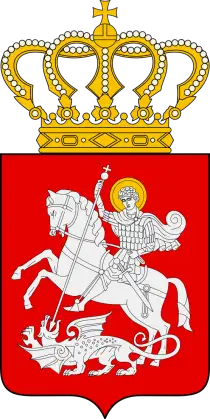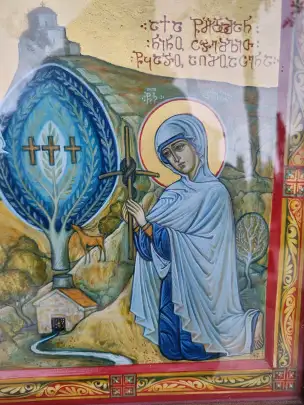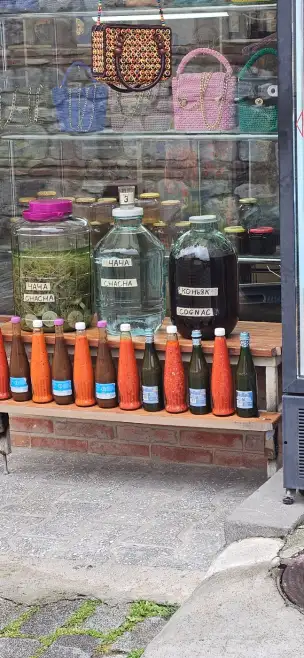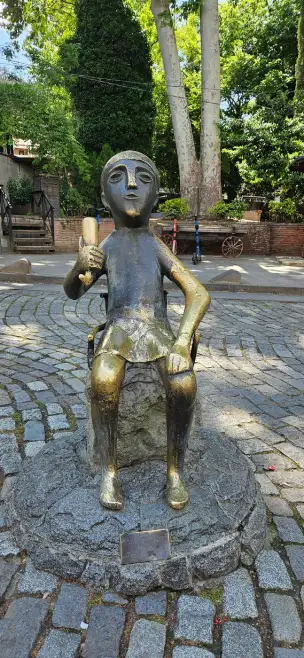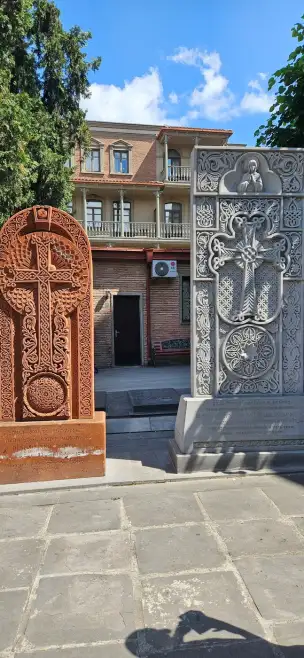Georgia has a rich history dating back thousands of years. It was part of ancient civilizations and, in later centuries, became an important kingdom and cultural center along the Silk Road.
Georgia attracts tourists with its beautiful landscapes, including the Caucasus Mountains, picturesque vineyards in the Kakheti region, ancient cities such as Tbilisi (the capital), the Samanid Mosque in Kutaisi, and monasteries in western Georgia.
The main religion in Georgia is Orthodox Christianity, which plays a significant role in the country’s social and cultural life. Georgia also has a long-standing Christian tradition.
After gaining independence from the Soviet Union in 1991, the country went through periods of political change and uncertainty but has been striving to develop its democracy and economy.
Georgia has a long history of winemaking and is recognized as one of the oldest wine-producing regions in the world. Viticulture is an important part of Georgian culture, and traditional wine-making methods, such as qvevri (clay vessels for fermentation), are still practiced today.
Odkryj najlepsze loty do blisko sto miast na różnych kontynentach. Sprawdź aktualne ceny i promocje.
Sprawdź loty do blisko sto miast na różnych kontynentachIs Georgia Safe?
Crime is as old as the world itself, as common as jokes about police officers, and multi-dimensional. For us as tourists, however, we are only concerned with the kind of crime that might affect our wallets while traveling on the Paris metro, not the type that quietly unfolds behind the walls of the Vatican or in the air-conditioned offices of Brussels.
But what is it like in Georgia?
Georgians themselves have varying opinions on the matter, and the situation is not helped by recent activity of Georgian criminal groups in Poland, although, according to experts, these are mostly people holding Georgian passports, mainly Chechens and Dagestanis. And you’ll hear the same from Georgians: there are certain regions in this ethnically diverse Caucasian mosaic that are better avoided, but when vacationing in Tbilisi or Batumi, you will feel 100% safe.
Separatist Regions in Georgia: Abkhazia and South Ossetia
Since the 1990s, these regions have been arenas for various smuggling and paramilitary groups, often linked to criminal organizations from Russia. Arms, drug, and human trafficking are serious problems there.
The High-Mountain Region of Svaneti
In the past, Svaneti was associated with mountain banditry and kidnappings for ransom, especially in the 1990s, when the central Georgian government was weak after the collapse of the USSR. In post-Soviet organized crime, Svans can still be found, particularly in networks connected with the “Thieves-in-Law” structures.
Today, Svaneti is primarily known as a tourist region, and the level of crime has dropped significantly. Moreover, despite warnings from Georgians from Kartli or Adjara, many of our compatriots choose this region as a travel destination, and I have yet to hear of anyone encountering trouble there.
Khinkali
Traditional Georgian dumplings filled with meat, usually made from raw beef, pork, or lamb, seasoned with onion, garlic, pepper, and coriander. What makes khinkali distinctive is that the meat inside is raw before cooking; during boiling, it produces a flavorful broth that remains trapped inside the dumpling.
They are eaten by hand: hold the dumpling by its twisted top, take a bite from the side, and drink the broth before eating the rest of the dumpling. The top knot is often left on the plate, as it is tougher and less tasty.
Different regions of Georgia have their own variations of khinkali—for example, in the mountains of Tusheti, lamb khinkali are popular, while in cities a mix of pork and beef is often used.
The Cross of Saint Nino – the Vine Cross
Saint Nino is a key figure in Georgia’s history, as Christian tradition holds that she converted the Georgians to Christianity in the early 4th century.
According to legend, she came from the region of present-day Turkey and arrived in Georgia in the first half of the 4th century to preach Christianity. She was known for her great charisma and miraculous powers, which are said to have persuaded King Mirian III and his wife Nana to embrace the new faith. Following the miraculous healing of the queen and a vision experienced by King Mirian, Christianity became the state religion of Georgia in 337 AD.
The distinctive cross associated with Saint Nino has arms that slope downward. Tradition says that Nino herself made it from vine branches and tied it together with her own hair.
This cross has become one of the main symbols of Georgian Christianity and national identity. It is present in many Georgian churches and icons and serves as a symbol of the Georgian Orthodox Church.
The Cross of Saint Nino can be seen in the Sioni Cathedral in Tbilisi, where a relic of it is kept, as well as in many other places of worship throughout Georgia.
Chacha
Chacha (Georgian: ჭაჭა, pronounced chacha) is a traditional Georgian high-proof spirit, often called “Georgian grape vodka,” similar to Italian grappa or Balkan rakija. Chacha is made from grape pomace—the stems, seeds, and skins left over after winemaking. Less commonly, other fruits such as figs, tangerines, or plums are used, but classic chacha is a byproduct of wine production.
Traditional homemade chacha can have an alcohol content ranging from 40% up to 65%! Commercial production usually stays around 40–45%.
Chacha is most often produced at home, especially in wine regions like Kakheti. In many households, making it is almost a ritual, passed down from generation to generation.
There are now brands that sell chacha as a premium spirit, often aged in oak barrels, which gives it an amber color and a smoother taste. Well-known producers include Askaneli Brothers, Sarajishvili, and Teliani Valley.
The name “chacha” comes from the Georgian word for grape pomace. In 2011, chacha was registered as a national product of Georgia with protected geographical indication. For Georgians, chacha is not just alcohol—it is a part of their identity and culture, especially in rural areas.
Can Georgia be called the cradle of wine?
Absolutely—Georgia can indeed be called the cradle of wine, and this is supported not just as a promotional slogan but by solid archaeological evidence and the continuity of tradition. Wine production in Georgia dates back over 8,000 years, making it the oldest known wine-producing region in the world.
The oldest findings related to winemaking are clay vessels with traces of fermented grape juice, dated to around 6000 BCE, discovered at Gadachrili Gora and Shulaveri Gora. Chemical analyses confirmed the presence of tartaric acid and microtraces of grape pollen (Vitis vinifera).
Georgians still use qvevri—large clay amphorae buried in the ground, in which wine is fermented and stored. This process differs from Western winemaking and is recognized by UNESCO as an intangible cultural heritage.
Georgia has over 500 local grape varieties, of which about 50 are currently used commercially:
- Saperavi – a deep red, slightly tannic, very expressive variety; a color-rich grape.
- Rkatsiteli – the most popular white grape variety.
- Mtsvane, Khikhvi, Tsolikouri, Ojaleshi – lesser-known but high-quality varieties.
Wine regions in Georgia:
- Kakheti – the most important region, producing over two-thirds of the country’s wine. Telavi and Sighnaghi are centers of wine tourism.
- Imereti – western Georgia, with a different qvevri style (less skin contact).
- Kartli, Racha, Lechkhumi, Samegrelo, Guria, Adjara – smaller regions, each with unique techniques and flavors.
Do Georgians really believe that Armenians rule the world?
On the West, we know this kind of joke too—like the Radio Yerevan quip: “Is it true that Armenians rule the world? Yes, but not Armenians, rather …” But let’s get to the point.
It is not a widespread belief, but in certain circles—especially among nationalists—one can encounter conspiracy theories about Armenian plots, schemes, and manipulations, mostly concerning politics and the economy.
Some nationalist groups, both in Georgia and in neighboring countries (e.g., Azerbaijan), promote the narrative that Armenians have disproportionate influence over Russian politics and propaganda. This narrative is not entirely disconnected from reality, considering the pro-Russian stance of some Armenian diaspora communities and the Armenian ancestry of some prominent figures in the current Moscow administration:
- Sergey Lavrov – Russian Foreign Minister since 2004, one of the longest-serving diplomats in the world. While he publicly identifies mainly with Russian nationality, his Armenian roots are sometimes highlighted by proponents of conspiracy theories.
- Margarita Simonyan – head of RT (formerly Russia Today), the Kremlin’s main propaganda channel. Her Armenian heritage is frequently emphasized, especially by critics of Russia in Georgia and Azerbaijan.
These stereotypes about Armenians are thought to originate in the 19th century, when Armenians formed the majority of Tbilisi’s population and controlled most of its shops, banks, and factories. For Georgians, who were often poorer and occupied lower positions in the social hierarchy, this dominance was hard to accept.
Although both Georgians and Armenians are Christian, cultural and religious differences mean that Georgians often emphasize their distinctiveness. Armenians are seen as more pragmatic and business-oriented, while Georgians are perceived as having a romantic attachment to their history and traditions.
Georgian Mountain Cattle
If you visit Georgia, you will almost certainly encounter small, agile, usually reddish cows that can jump over highway barriers and often cause traffic accidents—sometimes even becoming victims themselves.
This is one of the oldest cattle breeds in the Caucasus, raised mainly in the mountainous regions of Georgia, which essentially means throughout the country.
The first written mention of this breed comes from the Greek philosopher Aristotle, who noted: “Although a cow’s milk yield depends on its body mass, in Georgia (in Phasis) there are cows of very small stature that produce a lot of milk.”



